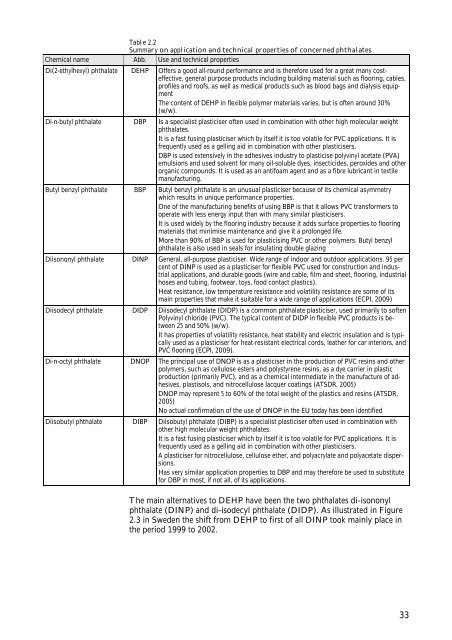Identification and assessment of alternatives to selected phthalates
Identification and assessment of alternatives to selected phthalates
Identification and assessment of alternatives to selected phthalates
You also want an ePaper? Increase the reach of your titles
YUMPU automatically turns print PDFs into web optimized ePapers that Google loves.
Table 2.2<br />
Summary on application <strong>and</strong> technical properties <strong>of</strong> concerned <strong>phthalates</strong><br />
Chemical name Abb. Use <strong>and</strong> technical properties<br />
Di(2-ethylhexyl) phthalate DEHP Offers a good all-round performance <strong>and</strong> is therefore used for a great many costeffective,<br />
general purpose products including building material such as flooring, cables,<br />
pr<strong>of</strong>iles <strong>and</strong> ro<strong>of</strong>s, as well as medical products such as blood bags <strong>and</strong> dialysis equipment<br />
The content <strong>of</strong> DEHP in flexible polymer materials varies, but is <strong>of</strong>ten around 30%<br />
(w/w).<br />
Di-n-butyl phthalate DBP Is a specialist plasticiser <strong>of</strong>ten used in combination with other high molecular weight<br />
<strong>phthalates</strong>.<br />
It is a fast fusing plasticiser which by itself it is <strong>to</strong>o volatile for PVC applications. It is<br />
frequently used as a gelling aid in combination with other plasticisers.<br />
DBP is used extensively in the adhesives industry <strong>to</strong> plasticise polyvinyl acetate (PVA)<br />
emulsions <strong>and</strong> used solvent for many oil-soluble dyes, insecticides, peroxides <strong>and</strong> other<br />
organic compounds. It is used as an antifoam agent <strong>and</strong> as a fibre lubricant in textile<br />
manufacturing.<br />
Butyl benzyl phthalate BBP Butyl benzyl phthalate is an unusual plasticiser because <strong>of</strong> its chemical asymmetry<br />
which results in unique performance properties.<br />
One <strong>of</strong> the manufacturing benefits <strong>of</strong> using BBP is that it allows PVC transformers <strong>to</strong><br />
operate with less energy input than with many similar plasticisers.<br />
It is used widely by the flooring industry because it adds surface properties <strong>to</strong> flooring<br />
materials that minimise maintenance <strong>and</strong> give it a prolonged life.<br />
More than 90% <strong>of</strong> BBP is used for plasticising PVC or other polymers. Butyl benzyl<br />
phthalate is also used in seals for insulating double glazing<br />
Diisononyl phthalate DINP General, all-purpose plasticiser. Wide range <strong>of</strong> indoor <strong>and</strong> outdoor applications. 95 per<br />
cent <strong>of</strong> DINP is used as a plasticiser for flexible PVC used for construction <strong>and</strong> industrial<br />
applications, <strong>and</strong> durable goods (wire <strong>and</strong> cable, film <strong>and</strong> sheet, flooring, industrial<br />
hoses <strong>and</strong> tubing, footwear, <strong>to</strong>ys, food contact plastics).<br />
Heat resistance, low temperature resistance <strong>and</strong> volatility resistance are some <strong>of</strong> its<br />
main properties that make it suitable for a wide range <strong>of</strong> applications (ECPI, 2009)<br />
Diisodecyl phthalate DIDP Diisodecyl phthalate (DIDP) is a common phthalate plasticiser, used primarily <strong>to</strong> s<strong>of</strong>ten<br />
Polyvinyl chloride (PVC). The typical content <strong>of</strong> DIDP in flexible PVC products is between<br />
25 <strong>and</strong> 50% (w/w).<br />
It has properties <strong>of</strong> volatility resistance, heat stability <strong>and</strong> electric insulation <strong>and</strong> is typically<br />
used as a plasticiser for heat-resistant electrical cords, leather for car interiors, <strong>and</strong><br />
PVC flooring (ECPI, 2009).<br />
Di-n-octyl phthalate DNOP The principal use <strong>of</strong> DNOP is as a plasticiser in the production <strong>of</strong> PVC resins <strong>and</strong> other<br />
polymers, such as cellulose esters <strong>and</strong> polystyrene resins, as a dye carrier in plastic<br />
production (primarily PVC), <strong>and</strong> as a chemical intermediate in the manufacture <strong>of</strong> adhesives,<br />
plastisols, <strong>and</strong> nitrocellulose lacquer coatings (ATSDR, 2005)<br />
DNOP may represent 5 <strong>to</strong> 60% <strong>of</strong> the <strong>to</strong>tal weight <strong>of</strong> the plastics <strong>and</strong> resins (ATSDR,<br />
2005)<br />
No actual confirmation <strong>of</strong> the use <strong>of</strong> DNOP in the EU <strong>to</strong>day has been identified<br />
Diisobutyl phthalate DIBP Diisobutyl phthalate (DIBP) is a specialist plasticiser <strong>of</strong>ten used in combination with<br />
other high molecular weight <strong>phthalates</strong>.<br />
It is a fast fusing plasticiser which by itself it is <strong>to</strong>o volatile for PVC applications. It is<br />
frequently used as a gelling aid in combination with other plasticisers.<br />
A plasticiser for nitrocellulose, cellulose ether, <strong>and</strong> polyacrylate <strong>and</strong> polyacetate dispersions.<br />
Has very similar application properties <strong>to</strong> DBP <strong>and</strong> may therefore be used <strong>to</strong> substitute<br />
for DBP in most, if not all, <strong>of</strong> its applications.<br />
The main <strong>alternatives</strong> <strong>to</strong> DEHP have been the two <strong>phthalates</strong> di-isononyl<br />
phthalate (DINP) <strong>and</strong> di-isodecyl phthalate (DIDP). As illustrated in Figure<br />
2.3 in Sweden the shift from DEHP <strong>to</strong> first <strong>of</strong> all DINP <strong>to</strong>ok mainly place in<br />
the period 1999 <strong>to</strong> 2002.<br />
33

















